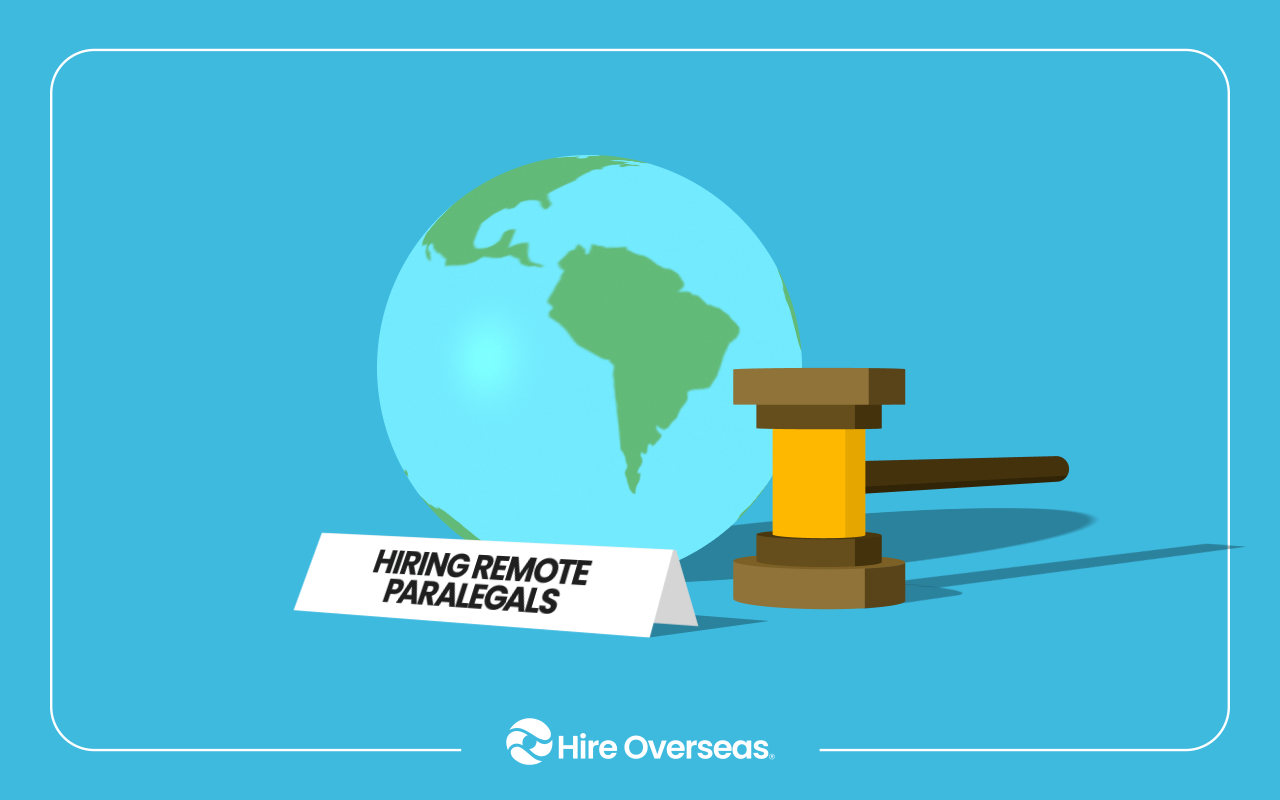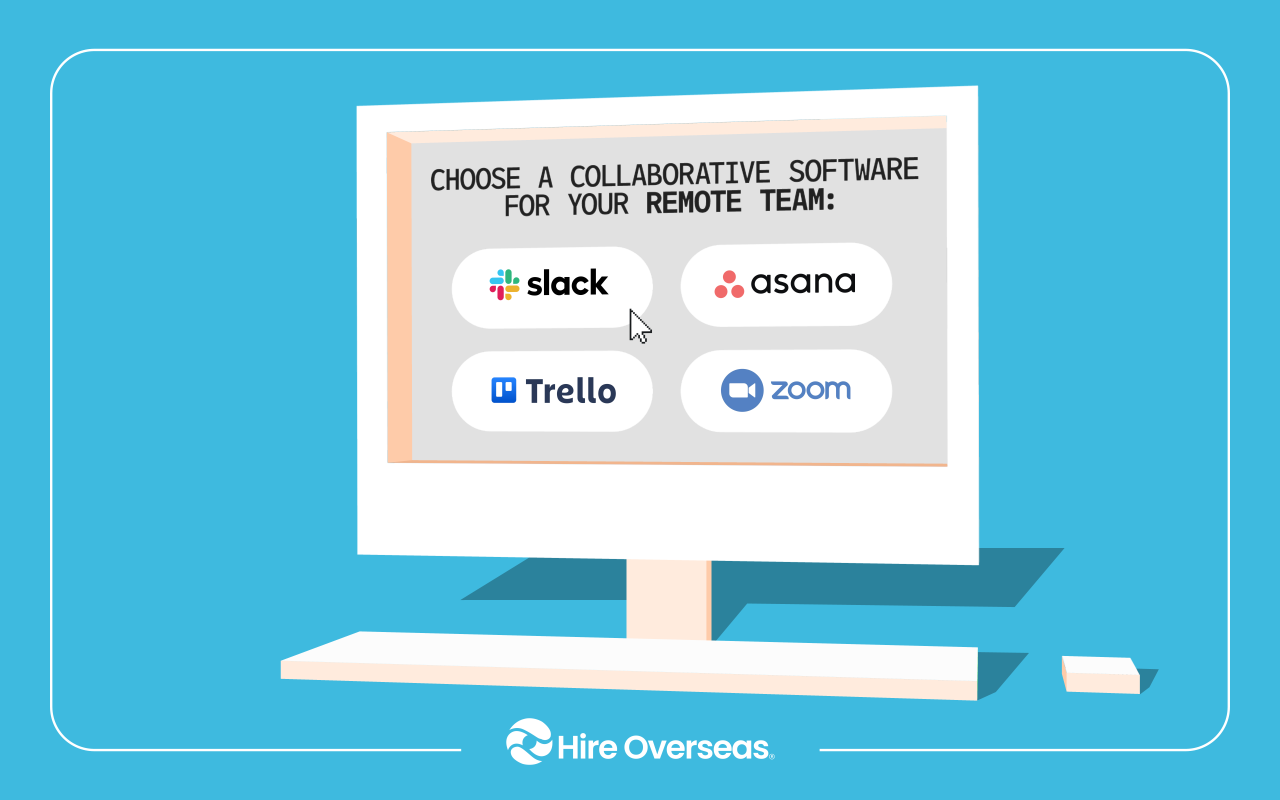Managing Global Remote Teams: A Leader’s Guide to Cross-Border Collaboration

Managing global remote teams is no longer an edge case—it is now the operating model of fast-scaling companies. Businesses that hire internationally gain access to specialized talent, 24/7 productivity cycles, and diverse perspectives that strengthen innovation. But, leading across borders introduces complexities that traditional remote work guides rarely address. Leaders must build trust with remote employees who may never share the same room, let alone the same country.
This guide breaks down how to manage global remote teams with clarity, consistency, and cultural intelligence so your distributed workforce stays aligned, engaged, and productive—no matter where they’re based.
Build a Global Operating System, Not Just a Workflow
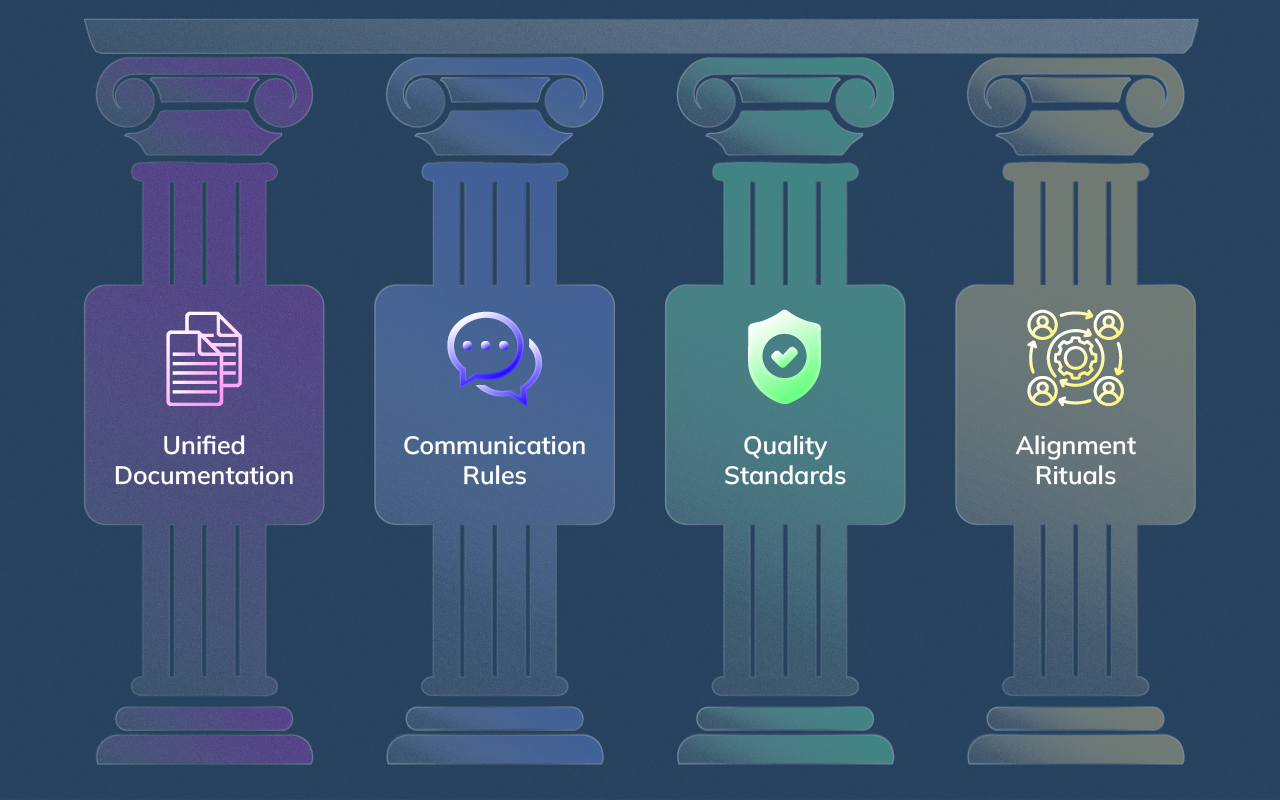
Global teams need standardized processes that work across countries, languages, and time zones. When teams are fully distributed, relying on improvisation creates gaps, misunderstandings, and duplicated work.
Elements of a strong global operating system:
- Unified documentation: SOPs, workflows, and decision guidelines that everyone can access.
- Clear communication rules: Define when to use chat, async updates, project tickets, or video calls.
- Shared definitions of quality: Every region should know exactly what “done” looks like.
- Alignment rituals: Weekly global priorities, monthly reviews, and quarterly goal-setting keep everyone anchored.
Managing distributed teams becomes easier when everyone follows the same operating system.
Want a deeper look into building high-performing offshore engineering teams? Explore our guide: How to Hire Offshore Development Teams
Turn Time Zones Into a Productivity Advantage
Many leaders view time zones as a challenge, but you can treat them as an efficiency multiplier.
How to manage remote teams across time zones:
- Apply “follow-the-sun” workflows: One region hands off work to the next for near-24/7 progress.
- Design async-first communication: Write detailed updates so teams don’t rely on synchronous calls.
- Keep only essential meetings: And rotate scheduling so no region is always disadvantaged.
- Define response-time expectations: This prevents frustration and keeps momentum steady.
When done right, time zone coordination accelerates global team productivity instead of slowing it down.
Strengthen Cross-Cultural Communication Through Intentional Structure
Global teams operate across cultural norms that affect communication, hierarchy, decision-making, and conflict resolution. Leaders must create clarity where cultural differences might create friction.
Best practices for managing virtual teams across cultures:
- Use explicit, direct communication. Replace implication with clarity.
- Avoid idioms, slang, or regional humor. They often don’t translate.
- Summarize decisions in writing. Global teams need written agreements more than verbal agreements.
- Train managers in cultural patterns. Understanding communication styles reduces friction.
Without cultural awareness, small misunderstandings quickly become recurring problems.
For more practical insights on communication, alignment, and remote leadership, read: Guide to Managing Remote Teams
Create Universal Standards for Performance and Accountability
Managing remote employees across different countries requires consistent benchmarks. Otherwise, each region will adopt its own pace and expectations.
Global performance management essentials:
- Create role scorecards for every region. Provide measurable KPIs that reward outcomes, not hours.
- Use objective metrics instead of subjective interpretations. Cultural differences affect communication styles, not performance.
- Record feedback asynchronously. This avoids misinterpretation.
- Train leaders to adjust feedback delivery. Direct vs indirect styles vary around the world.
Consistency allows global teams to stay aligned on performance without creating regional disparities.
Maintain High Engagement Without Relying on Real-Time Interaction
Employee engagement in remote teams drops fast when leaders rely on synchronous meetings. For global teams, asynchronous engagement matters more.
Engagement strategies that work across borders:
- Regional micro-teams: APAC, LATAM, EMEA groups that allow community without time zone strain.
- Global async celebrations: Recognition videos, shoutout channels, and milestone announcements.
- Localized recognition methods: Some cultures prefer private praise, others prefer public acknowledgment.
- Inclusive scheduling: Rotate global events quarterly.
Managing global remote teams requires a model that respects geography while preserving belonging.
Onboard International Talent With Context, Not Just Checklists
New hires in different countries enter with different norms, expectations, and assumptions. Global onboarding must reflect that.
Global onboarding best practices:
- Introduce your “company culture of communication.” Directness? Async-first? Documentation-heavy?
- Train on tools explicitly. Assume different levels of digital familiarity.
- Build 30-60-90 day plans for every region. Clarity accelerates productivity.
- Provide country-specific guidelines. Holidays, work hours, compliance rules, and security expectations.
Strong international onboarding builds confidence early and reduces alignment issues later.
Develop Leadership Skills for Global Remote Managers
Managing global remote teams requires leadership skills that go beyond typical management.
Essential global leadership skills:
- Context switching: Adjusting leadership style without stereotyping.
- Decision transparency: Explaining the “why” behind decisions to ensure alignment.
- Structured delegation: Breaking work into independent, async-friendly units.
- Boundary protection: Ensuring teams don’t work outside healthy hours to accommodate other regions.
Leaders must become translators of intent and facilitators of clarity.
Build a Remote Work Culture That Works Across Borders
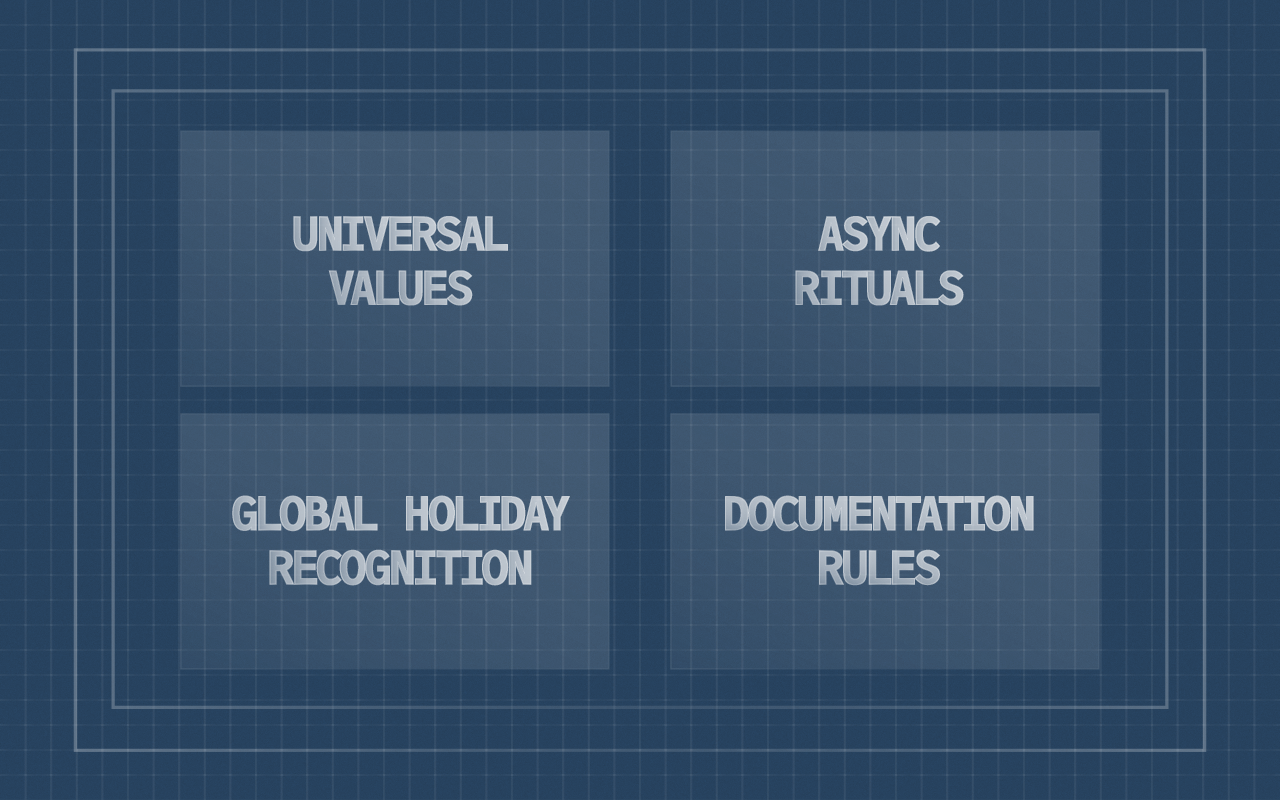
Remote work culture cannot be region-specific. It must be intentionally global.
How to build a global-first remote culture:
- Use universal values like clarity, ownership, and transparency.
- Create async rituals that everyone can participate in.
- Recognize global holidays, not just local ones.
- Document everything important. If it’s not written, it doesn't exist globally.
A strong culture keeps distributed teams connected even when they work continents apart.
Equip Your Team With Tools Designed for Global Collaboration
The right tools remove friction and support asynchronous communication workflows.
Recommended digital project management tools and collaboration platforms:
- Project management: Asana, Jira, Trello, ClickUp
- Async communication: Loom, Twist, Notion
- Real-time communication: Slack, Teams, Zoom
- Knowledge hubs: Confluence, Notion, Google Drive
- Security and access control: VPNs, device management, role-based permissions
- Tools become the infrastructure that holds global teams together.
Protect Well-Being and Avoid Burnout Across Regions
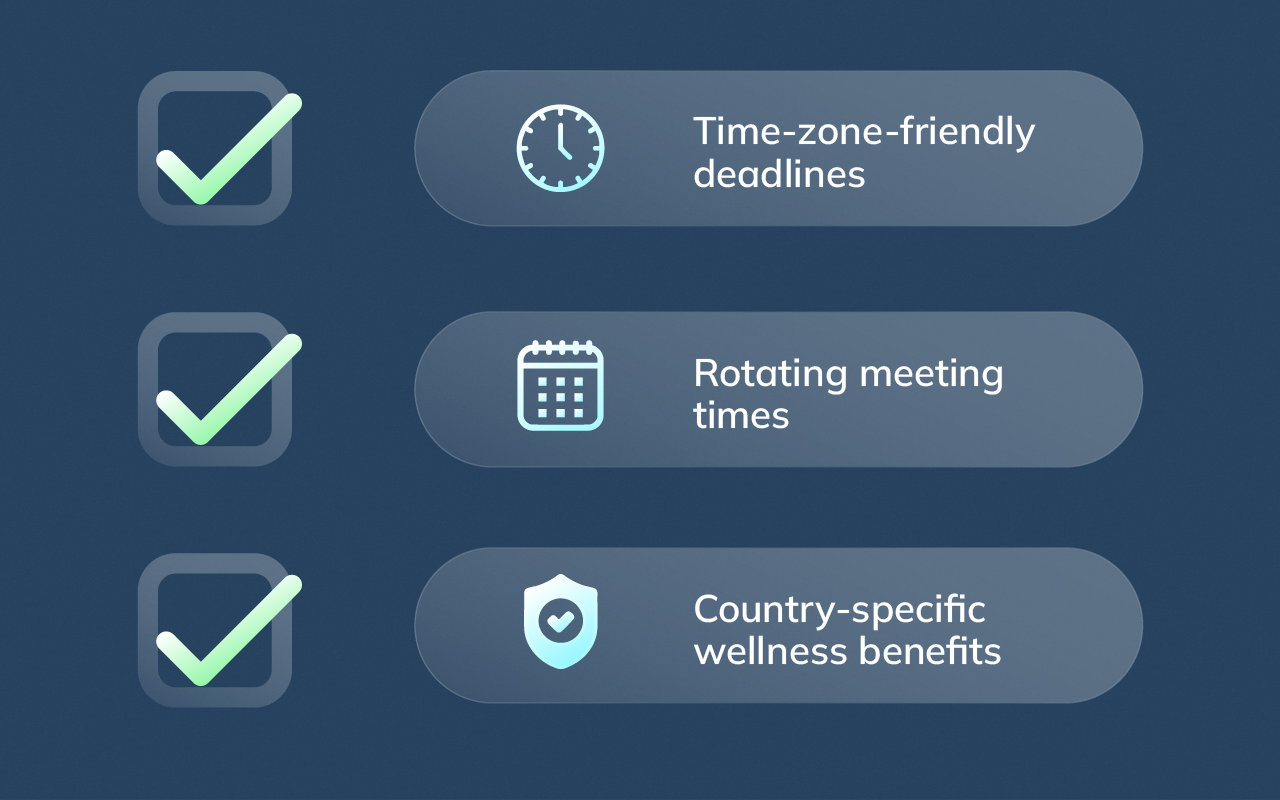
Global employees often unintentionally stretch their hours to collaborate with other time zones. Leaders must protect work-life boundaries proactively.
Ways to support well-being globally:
- No after-hours messaging across regions.
- Time-zone-sensitive deadlines.
- Rotating “inconvenient” meeting times.
- Local wellness benefits suited to each country.
Healthy teams stay productive and engaged long term.
[blog-cta_component]
Hire Overseas Insider: How to Manage Global Remote Teams Across Different Countries
After managing thousands of global remote hires across Asia, Africa, and Latin America, we’ve learned one thing clearly: every region brings something uniquely powerful to global teams. The key is not to manage everyone the same way but to understand regional strengths, common work patterns, and how to remove friction before it appears.
Below is a Hire Overseas country-by-country breakdown based on real operations, real problems, and the real systems we’ve built to make global collaboration smoother and more predictable—so clients get consistent performance and contractors feel supported and empowered.
How to Manage Filipino Remote Contractors
Filipino contractors are known for their warmth, excellent English skills, adaptability, and strong relationship-driven work style. They excel in customer support, admin work, creative roles, and operational coordination.
What we consistently love about Filipino talent:
- Extremely polite and respectful communication
- High service orientation and commitment to quality
- Reliable long-term loyalty when trust is built
- Strong cultural alignment with Western clients
Where challenges typically appear and how we solve them:
Challenge: Hesitation to ask questions or challenge unclear instructions
Solution: Proactively invite clarifications and normalize open communication
Challenge: Undersharing blockers
Solution: Use daily async check-ins and written updates
Practical tips:
- Provide clear, structured instructions
- Encourage questions and reassure them it’s welcomed
- Pair praise with actionable feedback
- Use SOPs to reduce ambiguity
Pro tip: Invest time building rapport early. Filipino contractors deliver their best work when they feel supported, valued, and connected.
How to Manage Sri Lankan Remote Contractors
Sri Lanka is a rising global talent hub, especially strong in finance, accounting, data operations, IT support, and administrative roles. Sri Lankan contractors are careful, punctual, and highly organized.
What stands out:
- Exceptional attention to detail
- Calm, steady work ethic
- High reliability and punctuality
- Strong English communication
Common challenges and the solutions we use:
Challenge: Hesitation to surface problems early
Solution: Set routine check-ins focused on blockers
Challenge: Over-politeness during feedback conversations
Solution: Use structured, balanced feedback frameworks
Practical tips:
- Set clear instructions and timelines
- Create predictable workflows
- Encourage transparent communication
- Acknowledge strong consistency
Pro tip: Sri Lankan contractors perform best inside well-organized systems with stable routines.
How to Manage South African Remote Contractors
South Africa is ideal for client-facing, sales support, and coordination roles thanks to strong English fluency and cultural alignment.
What we value highly:
- Direct, articulate communication
- Strong independence in problem-solving
- Comfort with Western work norms
- High professionalism in client interactions
Typical challenges and fixes:
Challenge: Infrastructure disruptions (e.g., load shedding)
Solution: Build asynchronous workflows and flexible deadlines
Practical tips:
- Communicate clearly and directly
- Offer autonomy and trust
- Give honest, balanced feedback
- Provide clear ownership of responsibilities
Pro tip: Reliability and consistent communication build strong bonds with South African contractors.
How to Manage African Contractors Outside South Africa
Kenya, Nigeria, Ghana, Uganda
These regions deliver adaptability, strong communication skills, and impressive versatility across roles.
What sets them apart:
- High resilience
- Strong English fluency
- Quick learning and adaptability
- Strong sense of responsibility
Challenges and solutions we use:
Challenge: Occasional internet/power interruptions
Solution: Use async workflows and flexible deadlines
Challenge: Limited early-career experience in structured environments
Solution: Provide detailed SOPs and training paths
Practical tips:
- Provide clear expectations
- Use SOPs to guide tasks
- Recognize strong initiative
- Offer development opportunities
Pro tip: Structure + empathy = exceptional long-term output.
How to Manage Latin American Remote Contractors
Mexico, Colombia, Argentina, Brazil
LATAM contractors excel in communication-heavy roles, marketing, sales support, creative work, and operations.
What we consistently love:
- Strong interpersonal communication
- Cultural alignment with U.S. clients
- Creativity and problem-solving
- Same-day collaboration thanks to similar time zones
Challenges and how we address them:
Challenge: Occasional preference for verbal over written updates
Solution: Standardize written documentation for clarity
Practical tips:
- Build rapport early
- Use collaborative communication styles
- Give timely, direct feedback
- Set clear project scopes and deliverables
Pro tip: A relational leadership style opens the door to exceptional performance.
Build a Global Team That Performs From Day One
Managing global remote teams becomes significantly easier when you combine the right leadership habits with world-class talent. Clear expectations, documented processes, and respect for regional working styles create an environment where global contractors can thrive. But the real multiplier is the quality of the people you bring in.
At Hire Overseas, we’ve built our reputation by vetting the top 1% of global contractors—professionals who communicate clearly, adapt fast, and deliver high-impact work without long onboarding cycles. Whether you're scaling operations, expanding into new markets, or building a distributed team, the right talent makes your systems stronger, your workflows faster, and your leadership more effective.
If you’re ready to build a global workforce that’s aligned, reliable, and capable of producing exceptional results from day one, we’re here to help.
Join the companies scaling faster with Hire Overseas’ top 1% global talent.
See how we vet, train, and deliver high-impact contractors ready to contribute immediately.
FAQs About Managing Global Remote Teams
How do you build trust with remote employees you’ve never met in person?
Trust develops through consistent communication, clear expectations, transparent decision-making, and reliable follow-through. Regular written updates, documentation of agreements, and structured feedback loops help build confidence even without physical interaction.
How do you create equal opportunities for global team members?
Rotate meeting times, recognize holidays in different regions, create transparent promotion criteria, and ensure all employees have equal access to documentation, training, and leadership visibility. Avoid region-based biases by using objective metrics and standardized scorecards.
What is the best way to handle conflict in a global remote team?
Address issues quickly, communicate expectations in writing, and avoid emotional or ambiguous language. Leaders should acknowledge cultural differences in conflict styles and use a neutral, structured framework (issue → impact → expected behavior → next steps).
How can leaders prevent burnout in distributed teams?
Implement strict after-hours policies for cross-time-zone communication, rotate meeting times, use regional workload balancing, and encourage asynchronous collaboration. Tailored wellness benefits and clear boundaries help sustain long-term global productivity.
How can companies scale a global workforce quickly without sacrificing quality?
Companies can scale globally at speed by using standardized SOPs, clear role scorecards, documented onboarding systems, and vetted talent pipelines that ensure every new hire meets consistent performance standards. Many organizations also partner with specialized global staffing providers that pre-screen candidates for communication skills, reliability, and technical competency to reduce hiring friction. For even faster scaling, businesses work with global talent experts like Hire Overseas, who not only source top-performing international contractors but also provide end-to-end talent management—ensuring consistent performance, smooth communication, and reliable long-term support.
Unlock Global Talent with Ease
Hire Overseas streamlines your hiring process from start to finish, connecting you with top global talent.

